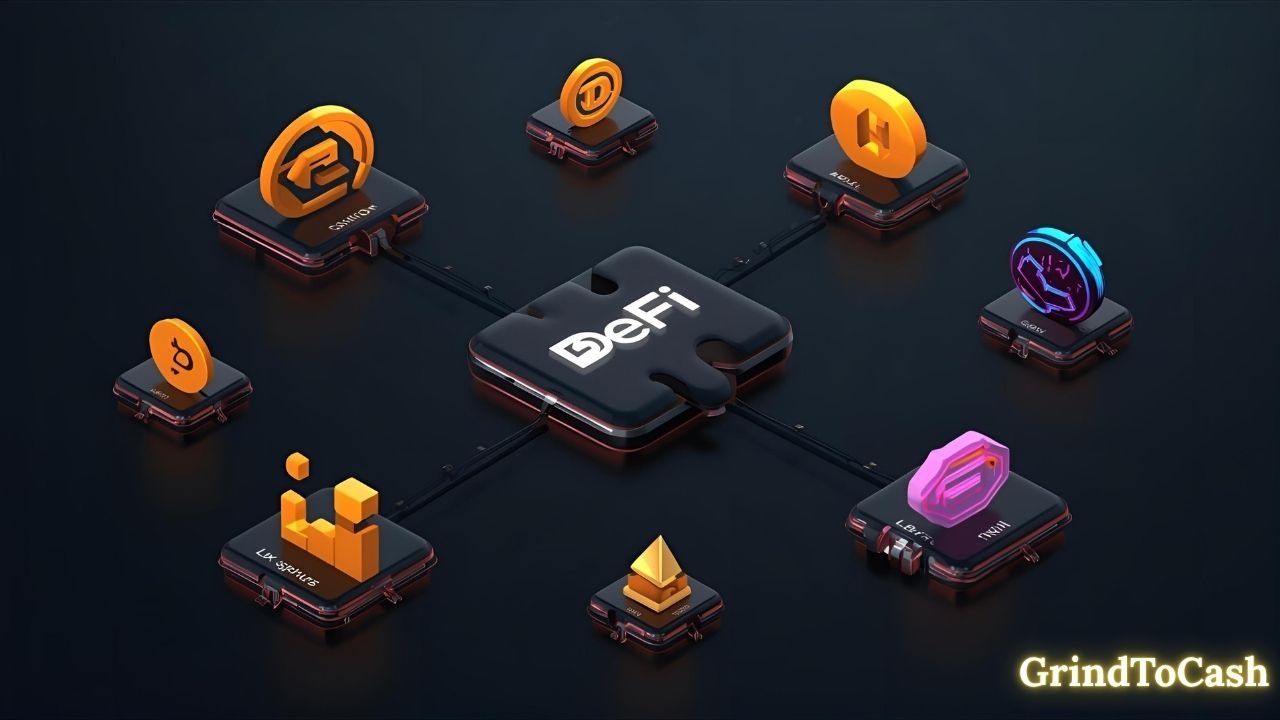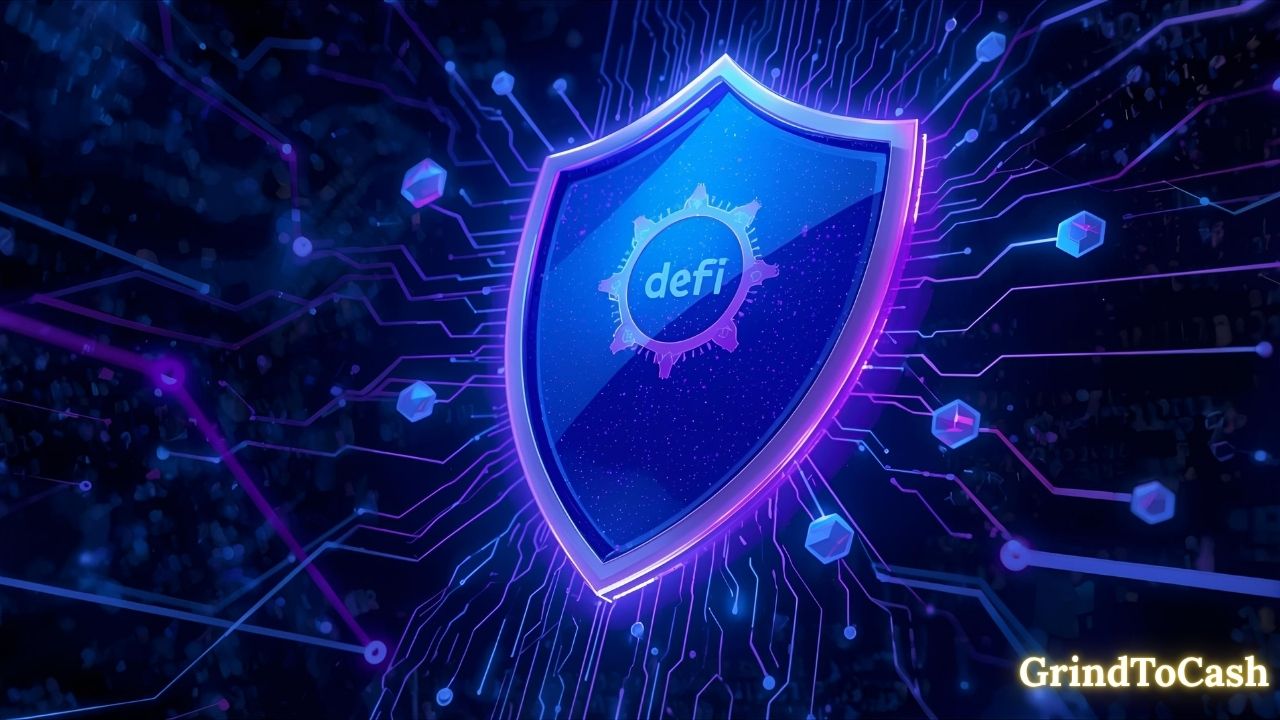Complete Guide to DeFi Niches: Farming, Lending & More
DeFi has split into many focused niches — each with its own tech, incentive models, and earning methods. This guide walks you through the most important DeFi niches, explains how they work, highlights practical ways to participate, and points out the key risks to watch. Read on and use these insights to make smarter choices on GrindToCash, whether you want passive yield, active strategies, or long-term exposure.
By Yaser | Published on October 3, 2025

What “DeFi Niches” Means and Why They Matter
DeFi niches are specialized sectors inside decentralized finance where similar protocols and business models cluster together. Examples include yield farming, lending, AMMs, and synthetic assets. Each niche has distinct revenue drivers, user behavior, and tooling. For investors and builders, niches matter because they reveal where liquidity flows, which teams focus their efforts, and how token economics are designed. By thinking in niches rather than single tokens, you learn to compare apples to apples, spot emerging opportunities early, and manage risk more intelligently across your crypto exposure.
How niches form in DeFi
Niches form when a few protocols solve a core problem well and others iterate on the idea. For example, automated market makers (AMMs) created a liquidity-provision niche that spawned many forks and specialized innovations. Over time, communities, tooling, and user habits concentrate around these patterns, creating recognizable niches.
Why niche knowledge improves decisions
Understanding a niche helps you evaluate projects faster. If you know standard revenue sources, security assumptions, and typical tokenomics for the niche, you can spot outliers and red flags quickly. This reduces guesswork and lets you size positions more rationally.
How GrindToCash uses niche analysis
At GrindToCash we group coverage by niche to help readers compare projects within the same category. This makes due diligence practical: you learn the common metrics, typical growth signs, and niche-specific risks that matter for real returns.

Yield Farming & Liquidity Mining: How to Earn from Providing Liquidity
Yield farming rewards users who provide liquidity to pools or stake tokens in protocols. Often, rewards include trading fees plus native tokens distributed as incentives. Historically, yield farming ignited DeFi growth by bootstrapping liquidity quickly. Today, farms are more sophisticated: many platforms combine fee income, reward emissions, and vault strategies. If you participate, you gain exposure to fees and token upside, but you also accept impermanent loss, smart-contract risk, and sometimes token emission dilution.
Basic mechanics of a yield farm
A yield farm typically requires you to supply a token pair to a liquidity pool or lock a single token in a staking contract. In return, you earn a share of trading fees and periodic reward tokens. Farms announce APY estimates, but remember APY can change rapidly with price moves and new reward emissions.
Impermanent loss and how to think about it
Impermanent loss occurs when the relative price of tokens in a pool changes. The loss is “impermanent” because it may reverse if prices return, but it can become permanent if you withdraw at a loss. Compare expected fee income to potential impermanent loss before adding liquidity.
Practical strategies: vaults and auto-compounders
Yield aggregators and vaults automate farming: they re-deploy rewards, optimize fee capture, and reduce manual risk. Vaults reduce friction for users, but they add centralized controllers or complex strategies — so check audits and withdrawal terms.

Lending & Borrowing: Interest, Collateral, and Liquidity Markets
Lending protocols let users earn interest by supplying assets, while borrowers take loans using collateral. Interest rates are often algorithmic, driven by supply and demand. Lending niches include over-collateralized loans, under-collateralized credit lines (emerging), and flash loans for arbitrage. For earners, lending can be a predictable yield source. For sophisticated users, borrowing enables leverage and capital efficiency. Yet lending carries smart-contract risk, oracle manipulation risk, and liquidation mechanics that you must understand before participating.
How on-chain lending markets set rates
Rates are typically algorithmic: when utilization rises, interest increases to attract lenders and cool borrowing. This model keeps markets balanced but can become volatile in stressed conditions. Look at utilization curves and reserve factors when choosing platforms.
Collateral, liquidation, and safety parameters
Borrowing requires over-collateralization on most DeFi platforms. Liquidations happen when collateral value falls below a maintenance threshold. Learn each protocol’s liquidation penalty and grace mechanisms; these details determine borrower risk and potential losses.
Ways to earn via lending strategies
You can supply assets to earn base interest, participate in collateralized yield strategies, or provide capital to money-market derivatives. Combining lending with stablecoin yield farming or using protocol-native incentives can boost returns, but it also compounds risk layers.

Staking & Liquid Staking Derivatives (LSDs): Passive Yield with New Tradeoffs
Staking secures proof-of-stake blockchains and rewards validators and delegators. Liquid staking derivatives (LSDs) let users stake while retaining a tradable claim (a derivative token). LSDs unlock capital efficiency: you can stake and still use the derivative in DeFi. This niche blends security incentives with composability, but introduces new counterparty and protocol risks. Understanding slashing risk, unstake delays, and LSD tokenomics is critical before shifting capital into these products.
Staking basics and validator models
Staking locks tokens with validators to secure the network. Validators earn rewards and share them with delegators but can be penalized (slashed) for misbehavior. Check validator reputation and decentralization metrics before delegating.
What liquid staking derivatives change
LSDs mint a token representing your staked position. This token can be used as collateral or in yield strategies. It increases capital efficiency but depends on the LSD protocol’s peg maintenance and redemption mechanics.
Yield stacking with LSDs: pros and cons
Using LSDs in other DeFi strategies can amplify yields. However, stacking protocols multiplies smart-contract dependencies and systemic risk. Keep position sizes sensible and diversify across protocols to manage cascading failures.

Decentralized Exchanges & AMMs: Trading, Fees, and Market Structure
AMMs power most on-chain trading by using liquidity pools and pricing curves instead of order books. This niche includes concentrated-liquidity AMMs, hybrid order-book models, and specialized DEXs for certain asset types. For liquidity providers, DEXs offer fee income. For traders, they offer permissionless swaps and arbitrage opportunities. However, slippage, front-running, and fragmented liquidity across chains are challenges. Choosing the right DEX depends on expected trade size, token pairs, and desired execution certainty.
How AMMs price assets and the role of curves
AMMs use algorithms (e.g., constant-product) to price assets based on pool balances. Newer designs allow concentrated liquidity to improve capital efficiency. Understand the curve mechanics before providing large liquidity.
Trading costs: fees, slippage, and MEV
Traders face fees and slippage; large trades can move prices. Miner/executor value (MEV) also affects execution fairness. Use limit-like solutions or batching to reduce adverse effects.
Cross-chain DEXs and aggregated liquidity
Cross-chain DEXs and aggregators route trades for best price. They add routing complexity and bridge risk, but for many traders they offer lower market impact and better fills.

Synthetic Assets, Derivatives & On-Chain Leverage
This niche creates tokenized exposures to off-chain assets (stocks, indices) or leveraged positions via decentralized derivatives. Synthetic protocols use collateral pools, oracles, and issuance mechanics to mirror asset performance. For investors, synthetics offer novel exposure without custody of the underlying. For builders, they require robust oracle design and liquidation systems. Risks include oracle failure, collateral shortfalls, and regulatory scrutiny. Still, synthetics expand DeFi’s use cases and draw capital looking for non-crypto or leveraged returns.
How synthetics mint and track price
Protocols mint synthetic tokens backed by collateral and rely on decentralized oracles for price feeds. Proper collateralization and reliable oracles are essential to keep synths redeemable and solvent.
On-chain leverage and perpetuals
Perpetual DEXs provide leveraged trading via funding rates and margining. They attract traders but require careful risk controls, insurance funds, and robust liquidation engines to survive volatile markets.
Regulatory and counterparty considerations
Synthetic exposures often attract regulatory attention. Additionally, counterparty and systemic risks grow as leverage concentrates. Monitor collateral quality and the protocol’s risk parameters before participating.

Insurance, Risk Markets & On-Chain Hedging
As DeFi matures, insurance and hedging niches grow. These protocols let users buy cover against hacks, smart-contract failures, or token price events. Some platforms use pooled capital and parametric triggers; others use markets to price risk. Insurance enhances credibility for other DeFi niches by transferring a portion of protocol risk. However, coverage terms, claims governance, and solvency are complex. As an investor, check policy limits, exclusions, and the insurer’s capital model before relying on coverage.
How on-chain insurance pools work
Insurance pools collect premiums and pay claims based on governance or parametric triggers. The pool size and diversification determine how much risk can be covered.
Hedging with options and credit-default products
DeFi options and credit-like instruments let users hedge downside. They are powerful but require understanding of expiry, implied volatility, and settlement mechanics.
Due diligence for insurance buyers
Read policy wording carefully. Look at historical claims, governance response speed, and whether the insurer holds sufficient reserves or reinsurance arrangements.

DeFi Infrastructure: Oracles, Bridges, and Developer Tooling
Infrastructure is the unsung DeFi niche that powers everything else. Oracles feed reliable price data, bridges transfer assets across chains, and indexers make data queryable. Good infrastructure reduces fragility and enables new niches to scale. For builders, choosing the right infra partners is a key product decision. For investors, infra tokens can provide exposure to long-term network effects. However, infrastructure failures (oracle manipulation, bridge exploits) can cascade across DeFi; therefore, protocol resilience and decentralization are crucial metrics.
Oracles: security and decentralization trade-offs
Oracles must balance speed, cost, and decentralization. Centralized oracles are faster but introduce single points of failure. Decentralized oracle networks are more robust but costlier. Evaluate the oracle model for critical contracts.
Bridges and cross-chain plumbing risks
Bridges increase composability but have historically been exploit vectors. Check whether bridges use multi-sig, validators, or federated models and whether they hold sufficient collateral to cover failures.
Developer tools and protocol composability
Tooling (SDKs, subgraphs, middleware) speeds development and builds ecosystems. Infrastructure that supports composability multiplies network value, but it also increases systemic coupling across protocols.








